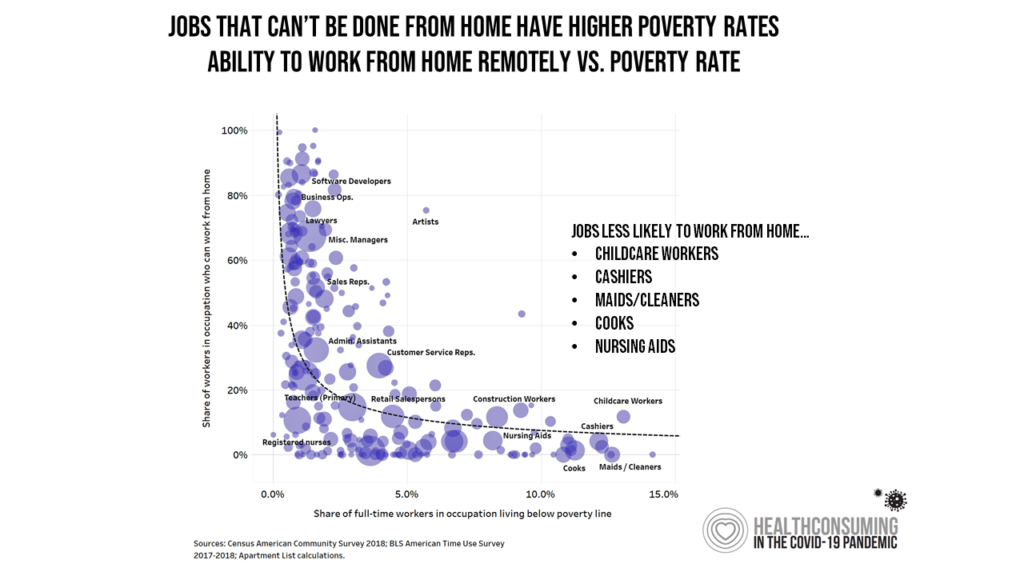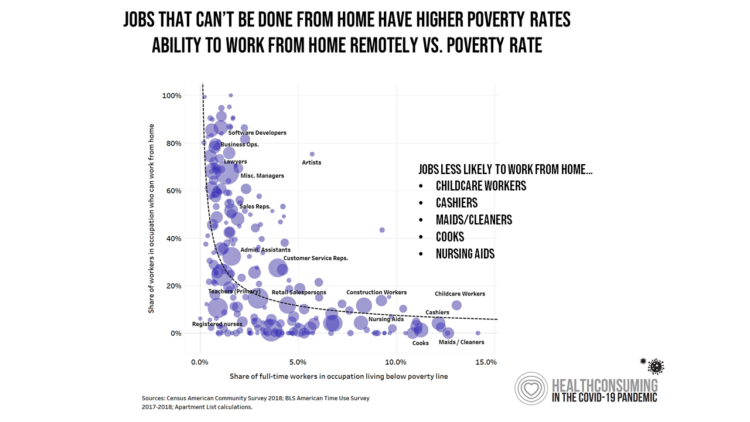Along with the life-threatening impact of the coronavirus on physical health, and the accompanying mental health distress activated by self-distancing comes a third unintended consequence with the pandemic: a hard hit on women’s personal economies.
The recession of the pandemic is considered by many economists as a “She-Cession,” a downturn in the economy that’s negatively impacting women more acutely than men.
This is markedly different than the Great Recession of 2008, the last major financial crisis: that financial decline was coined a “ManCession,” taking a more significant toll out of more typically men’s jobs like construction and manufacturing where fewer women worked.
This round of the pandemic Great Lockdown forced workers who could do so to work from home via online connections – their companies’ virtual private networks, and households’ broadband WiFi accounts. No longer could people even go to Starbucks and use the free WiFi connection as coffee shops were also shut down in the quarantine.
Home became where our work is, where our school is, where we cook and bake sourdough bread, where we stream entertainment, exercise and like Peloton again, and hunker down.
 The pandemic’s financial problem for women has been that the mass shut-down of the economy led to jobs being re-located to working-from-home. However, a plethora of service-industry jobs can’t be done remotely, leading to job-loss or furloughs.
The pandemic’s financial problem for women has been that the mass shut-down of the economy led to jobs being re-located to working-from-home. However, a plethora of service-industry jobs can’t be done remotely, leading to job-loss or furloughs.
And these jobs are more likely done by women.
As the purple bubble chart illustrates, jobs represented in the lower right corner are less likely to be able to work from home, garner lower incomes closer to the U.S. poverty rate. These jobs are also less likely to come with health insurance. If they were and jobs were lost, the lower-income laid-off worker would be unlikely to be able to pay for COBRA benefits for the right of retaining a health plan.
The jobs least likely to be able to work from home, these Bureau of Labor Statistics demonstrate, including childcare workers, retail employees, cleaning staff, cooks and food servers, and nursing aides.
Health Populi’s Hot Points: A new online publication, The 19th, features a detailed research piece called “America’s first female recession.”
This paragraph at the front of the essay sets the plot line:
“For the first time since they began a consistent upward climb in the labor force in the 1970s, women are now suffering the repercussions of a system that still treats them unequally. Men are still the primary breadwinners. Women are still the primary low-income workers, the ones whose jobs disappeared when coronavirus spread. Mothers in 2020’s pandemic have reduced their work hours four to five times more than fathers to care for children in a nation that hasn’t created a strong caregiving foundation.
“When the economy crumbled, women fell — hard.”
 The article describes the current decline in working women’s financial lives as a “consequence of years of occupational segregation,” with women’s work often in lower-paying jobs lacking benefits — particularly, health insurance and sick leave.
The article describes the current decline in working women’s financial lives as a “consequence of years of occupational segregation,” with women’s work often in lower-paying jobs lacking benefits — particularly, health insurance and sick leave.
In the pandemic, one-third of the female workforce such as grocery clerks and home health aides were designed as “essential workers,” with difficult choices whether to go to work, exposing themselves to the virus — or keeping a job and earning their living.
There is also a “caring crisis” for women in the pandemic. Women with school-aged children who work outside the home have dealt with childcare challenges as an integral role they play in their families — the so-called second-shift of work once a woman returns home from her job “outside.”
The 19th points out that, “The realities of the lopsided division of care inside American households has been on full display since work left the office and entered the home…Women in 2020 still take on the overwhelming majority of child care responsibilities, spending 40 percent more time watching their children than fathers in couples in which the parents are married and working full time,” based on new COVID-era research published by a team of economists from University of California San Diego, Northwestern University, and the University of Mannheim.
Their article assesses the impact of COVID-19 on gender equality, published in the April 2020 issue of COVID Economics from CEPR Press. [Yes, there is a new journal of vetted and real-time papers called “COVID Economics”].
The bottom-line here is that the pandemic recession is resulting in a widening gender wage gap, contributing to the continued lopsided distribution of division of labor in home work and child care, and diminished “within-household insurance.”
“This time it’s different,” the economist team asserts. Indeed: this time, in the COVID-driven she-cession, women are becoming acutely aware of their need for health security and, ultimately, health citizenship.





 Thanks to Feedspot for naming this blog, Health Populi, as a
Thanks to Feedspot for naming this blog, Health Populi, as a